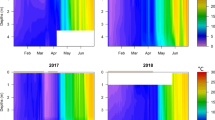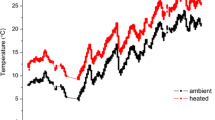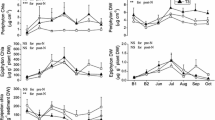Abstract
In turbid Pampean lakes, incident solar radiation is a major driver of plankton seasonal dynamics. Higher light availability in summer translates into higher primary production, and therefore more food for zooplankton grazers. However, experimental evidence suggests that food produced under the high irradiance conditions prevailing in summer are less suitable to sustain rotifer population growth than that produced under the lower irradiance conditions typical of winter. Here, we analysed time series datasets corresponding to three shallow lakes from the Salado river watershed. This analysis provided evidence for similar seasonal patterns of rotifer relative abundance over a large geographic area. In addition, we performed life table experiments to test the hypothesis that natural seston produced in winter could sustain higher population growth rates than seston produced in summer. We suggest that the natural seasonal changes in temperature and food generate successive time windows, which may be capitalized by the different grazer species, resulting in predictable phenology of grazer populations.
Similar content being viewed by others
Notes and references
H. E. Zagarese and C. E. Williamson, in The effects of UV radiation in the marine environment, ed. S. de Mora, S. Demers and M. Vernet, Cambridge University Press, London, 2000, p. 279.
L. De Meester, P. Dawidowicz, C. Loose and E. van Gool, in The ecology and evolution of inducible defenses, ed. R. Tollrian and D. Harvell, Princeton University Press, Princeton, New Jersey., 1999, pp. 160–176.
J. D. Orcutt, K. G. Porter, Oecologia, 1984, 63, 300–306.
T. C. Bunioto, M. S. Arcifa, Aquat. Ecol., 2007, 41, 569–578.
T. Weisse, H. Muller, R. A. L. Pinto-Coelho, A. Schweizer, D. Springmann, G. Baldringer, Limnol. Oceanogr., 1990, 35, 781–794.
N. Diovisalvi, V. Y. Bohn, M. C. Piccolo, G. M. E. Perillo, C. Baigún, H. E. Zagarese, Hydrobiologia, 2015, 752, 5–20.
A. S. M. Aoyagui, C. C. Bonecker, Acta Sci., Biol. Sci., 2004, 26, 385–406.
B. E. Modenutti, Hydrobiologia, 1998, 387/388, 259–265.
N. Neschuk, M. Claps, N. Gabellone, Ann. Limnol. - Int. J. Limnol., 2009, 38, 191–198.
D. Kuczynski, Hydrobiologia, 1991, 215, 135–152.
M. C. Claps, N. A. Gabellone, H. H. Benítez, Ann. Limnol. - Int. J. Limnol., 2004, 40, 201–210.
R. Adrian, N. Walz, T. Hintze, S. Hoeg, R. Rusche, Freshwater Biol., 1999,.
M. Devetter, Biologia, 2011, 66, 662–668.
M. Devetter, Hydrobiologia, 1998, 387/388, 171–178.
M. Winder, D. E. Schindler, Global Change Biol., 2004, 10, 1844–1856.
N. Diovisalvi, G. E. Salcedo Echeverry, L. Lagomarsino, H. E. Zagarese, Hydrobiologia, 2015, 752, 125–137.
A. Torremorell, M. Llames, G. Pérez, R. Escaray, J. Bustingorry, H. Zagarese, Freshwater Biol., 2009, 54, 437–449.
L. Lagomarsino, G. L. Pérez, R. Escaray, J. Bustingorry, H. E. Zagarese, Fundam. Appl. Limnol, 2011, 178, 191–201.
U. Gaedke, S. Hochstadter, D. Straile, Ecol. Monogr., 2002, 72, 616.
J. Urabe, M. Kyle, W. Makino, T. Yoshida, T. Andersen, J. Elser, Ecology, 2002, 83, 619–627.
G. Pérez, E. Llames, L. Lagomarsino, H. Zagarese, Photochem. Photobiol., 2011, 87, 659–670.
M. E. Llames, L. Lagomarsino, N. Diovisalvi, P. Fermani, A. M. Torremorell, G. Perez, F. Unrein, J. Bustingorry, R. Escaray, M. Ferraro, H. E. Zagarese, J. Plankton Res., 2009, 31, 1517–1529.
P. Starkweather, Hydrobiologia, 1980, 72, 63–72.
N. Walz, in Evolutionary ecology of freshwater animals, Birkhäuser, Basel, 1997, pp. 119–149.
R. S. Stemberger, J. J. Gilbert, Ecology, 1985, 66, 1151–1159.
J. Korstad, Y. Olsen, O. Vadstein, Hydrobiologia, 1989, 186/187, 43–50.
J. Flores-Burgos, S. S. S. Sarma, S. Nandini, Acta Hydrochim. Hydrobiol., 2005, 33, 614–621.
G. Weithoff, A. Wacker, Funct. Ecol., 2007, 21, 1092–1098.
K. Kirk, Freshwater Biol., 2002, 47, 1089–1096.
N. Walz, Experientia, 1995, 51, 437–453.
N. Walz, Hydrobiologia, 1987, 147, 209–213.
J. Arora, N. K. Mehra, Hydrobiologia, 2003, 491, 101–109.
M. J. González, T. M. Frost, Oecologia, 1992, 89, 560–566.
R. M. Pinto-coelho, Freshwater Biol., 1998, 40, 159–173.
R. S. Stemberger, M. S. Evans, J. Great Lakes Res., 1984, 10, 417–428.
C. M. Iachetti, M. E. Llames, Hydrobiologia, 2015, 752, 33–46.
E. L. Pavón-Meza, S. S. S. Sarma, S. Nandini, Hydrobiologia, 2005, 546, 353–360.
N. Diovisalvi, G. Berasain, F. Unrein, D. C. Colautti, P. Fermani, M. E. Llames, A. Torremorell, L. Lagomarsino, G. Pérez, R. Escaray, J. Bustigorry, M. Ferraro, H. Zagarese, Ecol. Aust., 2010, 20, 115–127.
K. Rothhaupt, Limnol. Oceanogr., 1995, 40, 1201–1208.
K. Kirk, Ecology, 1991, 72, 915–923.
J. Persson, P. Fink, A. Goto, J. M. Hood, J. Jonas, S. Kato, Oikos, 2010, 119, 741–751.
S. S. S. Sarma, T. R. Rao, Int. Rev. Gesamten Hydrobiol. Hydrogr., 1991, 76, 225–239.
A. M. Rennella, R. Quirós, Hydrobiologia, 2006, 556, 181–191.
A. Ruttner-Kolisko, Plankton Rotifers: Biology & Taxonomy, 1974,.
R. M. Pontin, A key to British freshwater planktonic Rotifera, Freshwater Biological Association, Ambleside, UK, 1978.
W. Koste, Rotatoria: die Radertiere Mitteleuropas: ein Bestimmungswerk begrundet von Max Voigt: Uberordnung Monogononta, Borntraeger, Berlin, 1978.
R. Koenker, K. Hallock, Econom. J. Econom. Soc., 1978, 33–50.
R Development Core Team, 2013,; http://www.R-project.org/.
L. C. Birch, J. Anim. Ecol., 1948, 17, 15–26.
T.R.E. Southwood, Bionomic strategies and population parameters, In Ecological methods, ed. R. M. May, Chapman & Hall, New York, 2nd edn., 1978, pp. 356–387.
J. Rabinovich, in Introducción a la ecología de poblacionales, ed. S. A. Compañía Continental, D. F. México, 1980, p. 313.
J. S. Meyer, C. G. Ingersoll, L. L. McDonald, M. S. Boyce, Ecology, 1986, 67, 1156–1166.
R. La Rossa, N. Kahn, Rev. Invest. Agropecu., 2003, 32, 127–142.
Author information
Authors and Affiliations
Corresponding author
Additional information
Electronic supplementary information (ESI) available. See DOI: 10.1039/c5pp00125k
Rights and permissions
About this article
Cite this article
Diovisalvi, N., Rennella, A. & Zagarese, H.E. Rotifer dynamics in three shallow lakes from the Salado river watershed (Argentina): the potential modulating role of incident solar radiation. Photochem Photobiol Sci 14, 2007–2013 (2015). https://doi.org/10.1039/c5pp00125k
Received:
Accepted:
Published:
Issue Date:
DOI: https://doi.org/10.1039/c5pp00125k




